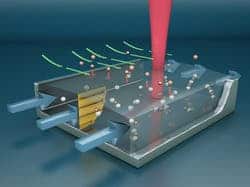In an age where the developing world is shadowed by paranoia in face of waves of terrorist attacks, no measure of precaution is spared. Preventing terrorist attacks has been a top priority for governments for a long time, especially since 9/11, and detecting explosives at critical check-ins like airport and customs makes for the first line of the defense. While we’re nearing 2013, dogs are still the gold standard for explosive detection and no man-made device has managed to come close to canine sensing accuracy – until recently that is.
Mechanical and chemical engineers at University of California, Santa Barbara have designed a detector that uses microfluidic nanotechnology to mimic the biological mechanism behind the dog’s sensing apparatus. Basically, they’ve developed a mechanical bomb sniffer based on the dog’s nose, which they claim is not only accurate, but actually more precise than the canine nose. If the device catches on – the scientists have already obtained a patent and exclusive licence – than it could become just as common in potentially hazardous zones like smoke detectors.
Previously, we’ve seen some interesting concepts for detecting explosives, from cutting-edge projects employing graphene layers to quite eccentric projects that use bee venom. The present showcased device, however, seems the most promising.
The team of researchers were led by professors Carl Meinhart of mechanical engineering and Martin Moskovits of chemistry,
“The device is capable of real-time detection and identification of certain types of molecules at concentrations of 1 ppb or below. Its specificity and sensitivity are unparalleled,” said Dr. Brian Piorek, former mechanical engineering doctoral student in Meinhart’s laboratory and Chief Scientist at Santa Barbara-based SpectraFluidics, Inc

Concept illustration of the microscale free-surface microfluidic channel as it concentrates vapor molecules that bind to nanoparticles inside a chamber. (c) University of California
An artificial bomb sniffer puts dogs out of work
The technology works by combining two key principles – free-surface microfluidics and surface-enhanced Raman spectroscopy (SERS) – to capture and identify molecules. One of the molecules they’ve targeted is 2,4-dinitrotoluene, the primary vapor emanating from TNT-based explosives. The substance comes in such a minute quantity that the human nose can not sense it, but dogs’ noses are sensitive enough to detect it. Inspired by the dog’s olfactory mucus layer, the scientists devised an artificial “sniffer”.
The device mainly consists of two parts – a microchannel, twenty times thinner than the human hair, which traps the target molecule for presenting it to the second part, a mini spectrometer power by a laser that detects the molecule. A computer database of spectral signatures identifies what kind of molecule has been captured, meaning that its uses are far from being limited only to detecting explosives; anything from noxious substances that can’t be senses otherwise to extremely sensitive sensors for scientific research could be employed.
“The technology could be used to detect a very wide variety of molecules,” said Meinhart. “The applications could extend to certain disease diagnosis or narcotics detection, to name a few.”
Moskovits added, “The paper we published focused on explosives, but it doesn’t have to be explosives. It could detect molecules from someone’s breath that may indicate disease, for example, or food that has spoiled.”
Their findings were published in the journal Analytical Chemistry.









